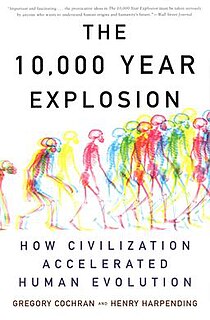
Steven Arthur Pinker is a Canadian-American cognitive psychologist, psycholinguist, popular science author and public intellectual. He is an advocate of evolutionary psychology and the computational theory of mind.

Gordon Matthew Thomas Sumner, known as Sting, is an English musician, singer, songwriter and actor. He was the frontman, songwriter and bassist for new wave rock band the Police from 1977 to 1984. He launched a solo career in 1985, and has included elements of rock, jazz, reggae, classical, new-age, and worldbeat in his music.

Singing is the act of producing musical sounds with the voice. A person who sings is called a singer or vocalist. Singers perform music that can be sung with or without accompaniment by musical instruments. Singing is often done in an ensemble of musicians, such as a choir of singers or a band of instrumentalists. Singers may perform as soloists or accompanied by anything from a single instrument up to a symphony orchestra or big band. Different singing styles include art music such as opera and Chinese opera, Indian music and religious music styles such as gospel, traditional music styles, world music, jazz, blues, ghazal and popular music styles such as pop, rock and electronic dance music.
An earworm, sometimes referred to as a brainworm, sticky music, stuck song syndrome, or, most commonly after earworms, Involuntary Musical Imagery (INMI), is a catchy and/or memorable piece of music or saying that continuously occupies a person's mind even after it is no longer being played or spoken about. Involuntary musical imagery as a label is not solely restricted to earworms; musical hallucinations also fall into this category, although they are not the same thing. Earworms are considered to be a common type of involuntary cognition. Some of the phrases often used to describe earworms include "musical imagery repetition" and "involuntary musical imagery".

Cantometrics is a method developed by Alan Lomax and a team of researchers for relating elements of the world's traditional vocal music to features of social organization as defined via George Murdock's Human Relations Area Files, resulting in a taxonomy of expressive human communications style. Lomax defined Cantometrics as the study of singing as normative expressive behavior and maintained that Cantometrics reveals folk performance style to be a "systems-maintaining framework" which models key patterns of co-action in everyday life. His work on Cantometrics gave rise to further comparative studies of aspects of human communication in relation to culture, including: Choreometrics, Parlametrics, Phonotactics, and Minutage.

How the Mind Works is a 1997 book by the Canadian-American cognitive scientist Steven Pinker, in which the author attempts to explain some of the human mind's poorly understood functions and quirks in evolutionary terms. Drawing heavily on the paradigm of evolutionary psychology articulated by John Tooby and Leda Cosmides, Pinker covers subjects such as vision, emotion, feminism, and "the meaning of life". He argues for both a computational theory of mind and a neo-Darwinist, adaptationist approach to evolution, all of which he sees as the central components of evolutionary psychology. He criticizes difference feminism because he believes scientific research has shown that women and men differ little or not at all in their moral reasoning. The book was a Pulitzer Prize Finalist.

Daniel Joseph Levitin, FRSC is an American-Canadian cognitive psychologist, neuroscientist, writer, musician, and record producer. He is the author of four New York Times best-selling books.
Margaret J. "Margie" Profet is an American evolutionary biologist with no formal biology training who created a decade-long controversy when she published her findings on the role of Darwinian evolution in menstruation, allergies and morning sickness. She argued that these three processes had evolved to eliminate pathogens, carcinogens and other toxins from the body.
Evolutionary musicology is a subfield of biomusicology that grounds the cognitive mechanisms of music appreciation and music creation in evolutionary theory. It covers vocal communication in other animals, theories of the evolution of human music, and holocultural universals in musical ability and processing.

"Spirits in the Material World" is a song by rock trio The Police, written by Sting. It is the opening track for their 1981 album Ghost in the Machine. It was released as a single in 1981 and reached No. 12 in the United Kingdom and No. 11 in the US in early 1982.
In psychology and cognitive neuroscience, pattern recognition describes cognitive process that matches information from a stimulus with information retrieved from memory.
Repetition is important in music, where sounds or sequences are often repeated. It may be called restatement, such as the restatement of a theme. While it plays a role in all music, with noise and musical tones lying along a spectrum from irregular to periodic sounds,(Moravcsik, 114)(Rajagopal, ) it is especially prominent in specific styles.
The evolutionary psychology of religion is the study of religious belief using evolutionary psychology principles. It is one approach to the psychology of religion. As with all other organs and organ functions, the brain's functional structure is argued to have a genetic basis, and is therefore subject to the effects of natural selection and evolution. Evolutionary psychologists seek to understand cognitive processes, religion in this case, by understanding the survival and reproductive functions they might serve.

In 2007 neurologist Oliver Sacks released his book Musicophilia: Tales of Music and the Brain in which he explores a range of psychological and physiological ailments and their intriguing connections to music. It is broken down into four parts, each with a distinctive theme; part one titled Haunted by Music examines mysterious onsets of musicality and musicophilia. Part two A Range of Musicality looks at musical oddities musical synesthesia. Parts three and four are titled Memory, Movement, and Music and Emotions, Identity, and Music respectively. Each part has between six and eight chapters, each of which is in turn dedicated to a particular case study that fit the overarching theme of the section. Presenting the book in this fashion makes the reading a little disjointed if one is doing so cover to cover, however, it also means one may pick up the book and flip to any chapter for a quick read without losing any context. Four case studies from the book are featured in the NOVA program Musical Minds aired on June 30, 2009.

This Is Your Brain on Music: The Science of a Human Obsession is a popular science book written by the McGill University neuroscientist Daniel J. Levitin, and first published by Dutton Penguin in the U.S. and Canada in 2006, and updated and released in paperback by Plume/Penguin in 2007. It has been translated into 18 languages and spent more than a year on The New York Times, The Globe and Mail, and other bestseller lists, and sold more than one million copies.
Cognitive musicology is a branch of cognitive science concerned with computationally modeling musical knowledge with the goal of understanding both music and cognition.

The 10,000 Year Explosion: How Civilization Accelerated Human Evolution is a 2009 book by anthropologists Gregory Cochran and Henry Harpending. Starting with their own take on the conventional wisdom that the evolutionary process stopped when modern humans appeared, the authors explain the genetic basis of their view that human evolution is accelerating, illustrating it with some examples.
The Levitin effect is a phenomenon whereby people, even those without musical training, tend to remember songs in the correct key. The finding stood in contrast to the large body of laboratory literature suggesting that such details of perceptual experience are lost during the process of memory encoding, so that people would remember melodies with relative pitch rather than absolute pitch.

Connectome: How the Brain's Wiring Makes Us Who We Are (2012) is a book by Sebastian Seung. It introduces basic concepts in neuroscience and then elaborates on the field of connectomics, i.e., how to scan, decode, compare, and understand patterns in brain connectivity. The book concludes with musings on cryonics and mind uploading. It was selected by The Wall Street Journal as Top Ten Nonfiction of 2012.
Aniruddh (Ani) D. Patel is a cognitive psychologist known for his research on music cognition and the cognitive neuroscience of music. He is Professor of Psychology at Tufts University. From a background in evolutionary biology, his work includes empirical research, theoretical studies, brain imaging techniques, and acoustical analysis applied to areas such as cognitive musicology, parallel relationships between music and language, and evolutionary musicology. Patel received a Guggenheim Fellowship in 2018 to support his work on the evolution of musical cognition.











